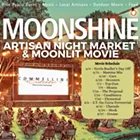On the other hand, the 16 contemporary works are from "big name" artists you could only view in the "big city," e.g., Seattle (a five-hour drive) or New York (an eight-hour flight, not including 10 hours in airport security). You could scope out Andy Warhol or Roy Lichtenstein online (or just get the Museum's accompanying full-color catalog), but it really isn't the same.
Museum Director Chris Bruce explains: "Basically, I feel that our audience -- students in particular -- have a right to see in person the art they see in books. There's a huge difference, for example, between seeing the Frank Stella [painting] reproduced (where it looks absolutely mechanical and pristine) and the Stella in person, where you can see pencil lines and bleeding at the edges ... Or the wonderful perceptual qualities of [a sculpture by Donald] Judd, which in reproduction just looks like a big box."
So what's half a tank of gas? Guess it all depends on your point of reference. Which is exactly what this show is about: context.
Art & amp; Context ambitiously attempts to convey what Bruce describes as arguably "the most radical change from one generation to another in the history of art." This period, from 1950 to 1970, was a transformative time in American history as well. A bit of context helps clarify both the societal changes and the shifts in art history
Many folks, for example, understand the importance of the Civil Rights movement. Yet few know how Piet Mondrian's Constructivist compositional paintings, such as Broadway Boogie Woogie, revolutionized the way in which some artists -- including many in the WSU exhibit -- began to think about color, painting and art itself.
Who, then, is the target audience of this exhibit? Students, of course, as well as surrounding communities, says Bruce, whose team focused on providing general historical context in which to view the artworks. They accomplished this through signage (partially designed by WSU students) that highlights key developments of the '50s and '60s in such arenas as gender and race, politics, and the media. Replete with pictures -- Ray Bradbury's Fahrenheit 451, Marilyn Monroe on the cover of Playboy, Marshall McLuhan's The Medium Is the Massage -- the signs provide a good overview of the turbulent times in which the only constant was change itself.
Thus Alexander Calder's ever-changing kinetic sculpture, which greets entrants to the museum's light-filled gallery, is an apt metaphor. Other conceptual links between art and society include Warhol (think soup cans) and Lichtenstein (enlarged Sunday comics), whose emphasis on commercialism is apropos for a culture in which television ownership grew from 9 percent of households in 1950 to nearly 90 percent by the late '60s.
Beyond these examples, however, it is a stretch to suggest that the average viewer will easily connect what was happening in society with what was happening in art. How, for example, does Eva Hesse's latex wall hanging relate to the Kennedy assassination? How does Willem de Kooning's "Woman with Smile" relate to Betty Friedan's The Feminine Mystique? The answer is: They don't. It's implicit that societal changes happened concurrently with artistic developments. What is not expressed -- beyond abbreviated information on captions accompanying each artwork -- is what the viewer needs to really grasp the import of this generational shift: art history.
The exhibit does draw a distinction between major 1950s and '60s art movements. The former is dominated by Abstract Expressionism as represented in the works of Joan Mitchell and de Kooning. (Jackson Pollack is featured in the catalog but deemed too fragile for exhibition.) Abstract Expressionism, a distant grandson of Impressionism, advocated primacy of paint and process over the resulting image. The 1960s, in contrast, were dominated by "non-art" art like Color Field painting -- represented here by Louis Morris, Frank Stella and Kenneth Noland, whose work emphasized form and color over expression and the artist's mark. Sculpture included Minimalist, with ties to De Stijl and Bauhaus (even Cubism, I'd argue), as well as Pop Art -- such as Claes Oldenburg's scale model of a trowel. Pop Art (remember Oldenburg's giant soft-sculpture toilet?) united formalist concerns of Minimalism with Dada non-sensibilities.
Without this knowledge, the impact is lost, especially for artworks that link the two movements, such as those by Mark Rothko and Robert Rauschenberg. To complicate matters, the dates on the individual works, such as de Kooning's Abstract Expressionist example dated 1967, do not always jibe with the timeframe of the movement they represent.
More examples by artists whose works bridged the gap between the two time periods include Helen Frankenthaler, Hans Hoffman, Franz Kline and Jasper Johns -- although, as with Pollack, Johns' work is included in the catalog but not the exhibition. The reason these artworks weren't included has to do with how they were obtained. Explains Bruce, "We wanted to borrow works only from the regional collections, partly since there are so many great works in those collections." Those collectors include Virginia and Bagley Wright, who transformed both the Seattle Art Museum and Western Washington University's outdoor sculpture program; Jane and David Davis; and a host of other donors without whose support the exhibition could not have happened.
Would the Museum have liked to show more artists or do more to educate viewers about art history? Yes, says Bruce, but "you can only do so much ... this is not intended to be the entire history of modern art, but a representative snapshot of a key period of time."
To that end, we return to the question of value. Is the WSU exhibit worth the trip? You'll have to decide for yourself.
"Art & amp; Context: the '50s and '60s" runs through Dec. 15 at the WSU Museum of Art. Gallery hours: Monday-Saturday 10 am-4pm, Thursday until 7 pm. Free. A series of lectures is planned. Visit www.wsu.edu/ artmuse or call (509) 335-1910.















